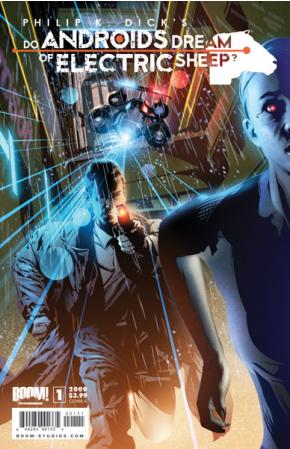
Philip K. Dick was known for his bizarre take on the future, his paranoid and delusional characters and strange, unexpected twists. While other authors were churning out utopian futures based on scientific advancements that improved the human condition, Do Androids Dream of Electric Sheep? painted a future of rot and decay where the Earth is a slum that normal people want to escape from physically, while the genetically-challenged escape in their minds. Moods are dialed up and served like noodles or rice — any way you like it. Animals are rare, many extinct, and it’s become an obligation to care for them, your duty as a human. The world’s gods have been replaced by Mercer, a man whose struggles you can tune into virtually and find your humanity in the Unity of the struggle. Androids that have replaced human workers in the off-world colonies have become so life-like, you wouldn’t know if the guy next to you was a human or an “andy”.
Enter Rick Dekard, bounty hunter. His job is to find and “retire” andies who have escaped their masters and fled back to Earth to hide. With the lead bounty hunter in his area laid up in the hospital after a hunt went wrong, Dekard finds himself with the task of tracking down and retiring six andies.
Do Androids Dream of Electric Sheep? is considered to be PKD at his best. It was the basis for the film Blade Runner, which for many was an introduction to PKD’s work. (Other film adaptations of PKD’s work include Next, Total Recall, Minority Report and Paycheck). In BOOM! Studios’s Do Androids Dream of Electric Sheep? they’ve chosen to celebrate the brilliance of the original story by illustrating it and including the full, unaltered text of the original novel. Blade Runner has been celebrated over and over again with re-masters, re-edits and director’s cuts. It’s about time Do Androids Dream of Electric Sheep? gets its turn.
A blend of traditional and digital illustrations, each issue has three alternate covers for the enthusiasts who want to try to collect them all, and has more than thirty high-quality pages. Each issue also includes backmatter, commentary included in the final pages by various authors who were greatly influenced by PKD’s work. The heavy pages are inked from edge to edge and are absolutely gorgeous. The price tag of $3.99 is a bargain considering how much you get and what you find between the covers.
Tony Parker’s artwork tells the story just as surely as PKD’s words do, and the colors by BLOND give the world and the characters depth and dimension. The contrast between light and shadow is as dramatic as the muted and glowing colors that spill across the pages. The illustrations are so rich and every frame seems photo-like. No busy or blank backgrounds here. Everything is well-balanced and compliments PKD’s story. In the first issue, there were a few pixelated images that may or may not have been intentional, but with the exception of that, these images are sharp and impressive.
Do Androids Dream of Electric Sheep? will be released as a 24-part maxi series, the first three issues of which are currently available from BOOM! Studios or your local comic shop. Regardless of whether you are a comic book collector, a fan of the film Blade Runner, or a Philip K. Dick fanatic like me, Do Androids Dream of Electric Sheep? is definitely worth adding to your collection.